Dive Details
Location
Date
Thursday 23 May 2019
Time
9:35am - 11:41am
Seas
Some surge
Visibility
3 to 15 metres
Duration
126 minutes
Surface interval
Maximum depth
21.3 m
Average depth
15.4 m
Water temperature
20.3°C
Dive Profile from Citizen Hyper Aqualand
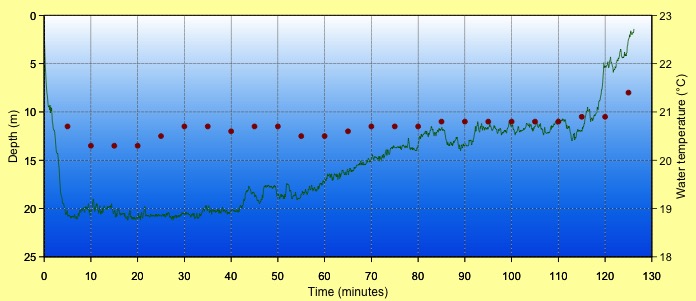
Tides at Botany Bay AEST
Note that tides at dive site may vary from above location.
Low
5:45am
0.51m
High
11:43am
1.29m
Low
5:01pm
0.75m
High
11:33pm
1.71m
Details
It was two weeks since I last dived The Leap due tides, working and still recovering. Conditions looked great with calm seas and the water looked clear. I was excited.
I jumped in from the low platform and swam out on the surface. The visibility was well over 5 metres as I could see the bottom clearly. I descended and made my way to the amphitheatre at around 60°. There was a bit of current and I had to keep correcting my heading. The visibility was 10 to 15 metres and looked awesome... until I reached the amphitheatre. As I descended past 15 metres into the amphitheatre the visibility dropped to around 3 to 5 metres. It wasn't so bad I couldn't navigate but it was disappointing as it had been so promising. The water temperature was between 20 and 21°C. There wasn't much surge or current and it was difficult to understand why the visibility was so poor.
I made my way to the first rock in Field of Pygmies. There have been so few pygmy pipehorses in the area of late the name is almost meaningless. I looked on the first rock and found no pygmies. I looked on the adjacent rock and also found none.
I made my way to the flat rock with sponges which was not easy because of the less than ideal visibility. I finally found the rock but was not able to find any pygmies.
I continued to Bob & Lucy rock and found no pygmies there or on the adjacent rocks.
I swam along the sand line to Ian's Pygmy Rock. I looked for Weedy Seadragons along the way. I was looking on the rock immediately before Ian's Pygmy Rock when I spotted a small juvenile pygmy (IL2019052301). Hopefully, this is the start of a lot more.
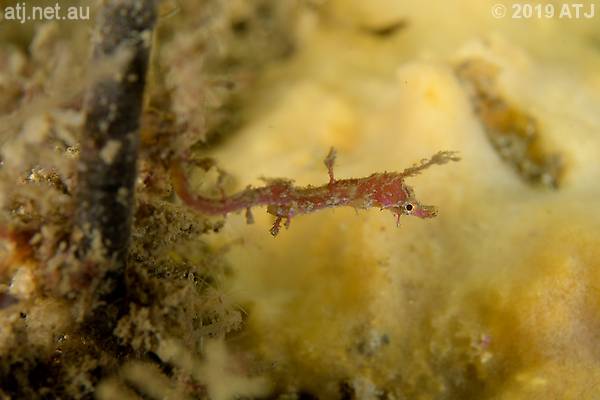
Juvenile Sydney Pygmy Pipehorse, Idiotropiscis lumnitzeri, (IL2019052301). 20.8m.

Juvenile Sydney Pygmy Pipehorse, Idiotropiscis lumnitzeri, (IL2019052301). 20.7m.
I continued on towards Seahorse Rock. I looked on the first of the two smaller rocks out on the sand for the pygmy I had found two weeks ago. I initially couldn't see any and then I spotted one in the algae. It was the same one as 2 weeks ago (IL2019050901).
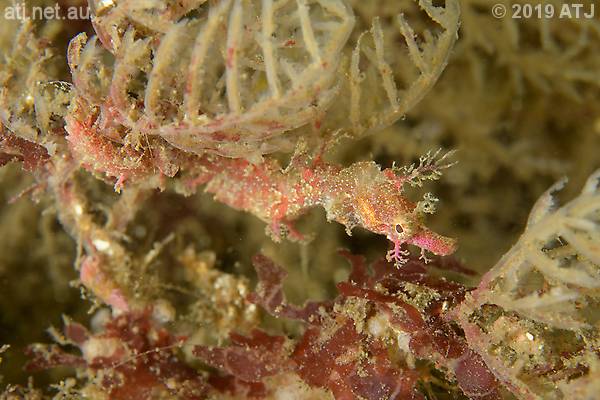
Male Sydney Pygmy Pipehorse, Idiotropiscis lumnitzeri, (IL2019050901). 20.5m.
I headed past Seahorse Rock and looked around the rocks for Ron's Red-fingered Anglerfish but couldn't find it. I looked on the sand between Seahorse Rock and the flat rocks with sponges for Weedy Seadragons. I found "Clyde", a juvenile, and the female. The regular male was not there. I checked under the overhang and in the kelp below the pygmy pipehorses but still couldn't find him.

Weedy seadragon, Phyllopteryx taeniolatus, ("Clyde"). 20.2m.

Weedy seadragon, Phyllopteryx taeniolatus, ("Clyde"). 20.4m.

Juvenile Weedy Seadragon, Phyllopteryx taeniolatus. 20.4 m.

Juvenile Weedy Seadragon, Phyllopteryx taeniolatus. 20.2 m.

Weedy Seadragon, Phyllopteryx taeniolatus. 20.2m.
I looked for pygmy pipehorses on the rock above but found none.
I followed the sand line to Sheree's Pygmy Rock. I looked for pygmy pipehorses and found a female.

Female Sydney Pygmy Pipehorse, Idiotropiscis lumnitzeri. 17.7m.
I continued on to Southern Cross Rock. I was about to look for pygmy pipehorses in the usual spot on the side of Southern Cross Rock when I saw a huge stingray sitting on the sand. It was facing away from me with its tail less than a metre from the spot I wanted to look. I wasn't going to risk it so I swam to the top of Southern Cross Rock and moved slowly into its field of view. It moved off slowly but left a cloud of sand. I went back to the side of the rock to look for pygmy pipehorses but found none.
I swam on into Seadragon Alley. I looked for weedies as I swam through but saw none. At the end of Seadragon Alley I looked for red Stigmatopora sp. pipefish in the red algae.
I headed up the slope towards Big Rock still looking for pipefish in any of the red algae I encountered. I found one of the juvenile Bridled Triggerfish on the way.
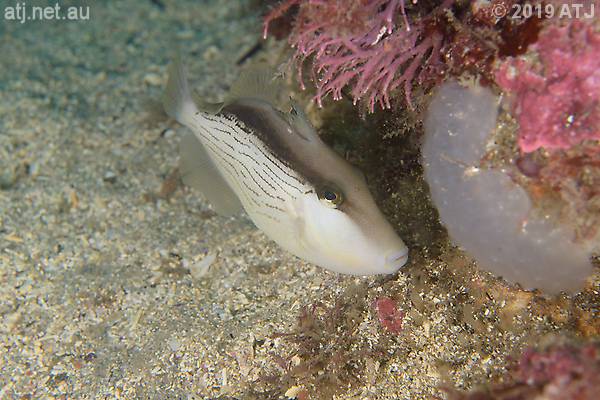
Juvenile Bridled Triggerfish, Sufflamen fraenatum. 15.4m.

Juvenile Bridled Triggerfish, Sufflamen fraenatum. 15.4m.
I rounded the bottom of Big Rock and swam up to Hand Rock. I was hoping to see the tiny pygmy pipehorse I'd found last Saturday and seen again on Sunday. I could not find it.
I swam past Slope Rock and then spotted the small salmon Red-fingered Anglerfish that had been on Slope Rock. It was on the side of the rock where I had seen a male pygmy pipehorse heading ready to give birth.
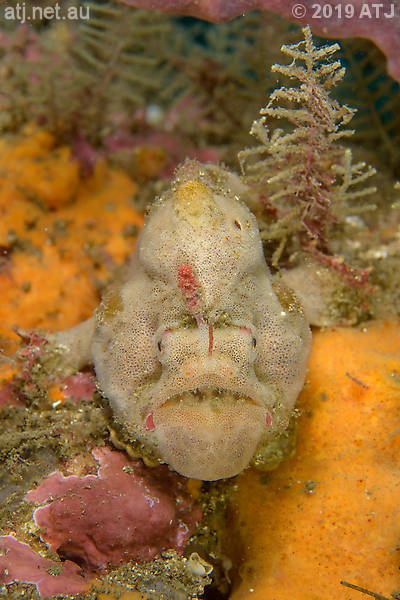
Red-fingered Anglerfish, Porophryne erythrodactylus. 14m.
I looked around the rocks in the area for George's orange Red-fingered Anglerfish. I looked on the rock where the seahorse with one eye had been but didn't see it. I looked on the adjacent rocks and still couldn't see it. I checked the one-eyed seahorse rock again and spotted it.
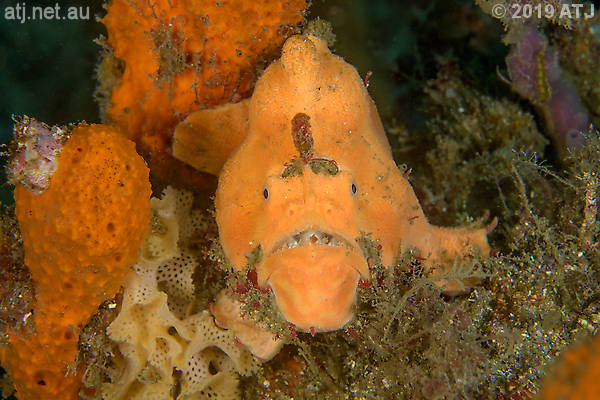
Red-fingered Anglerfish, Porophryne erythrodactylus. 11.8m.
I swam along to the top of the reef to the rocks where the white male pygmy pipehorse had been. I looked for pygmy pipehorses on that rock but found none.
I continued on towards Diversity Rock. On the way I looked for the small orange Red-fingered Anglerfish with the black spot under its right eye. It wasn't on the rock where I first saw it 2 weeks ago but then I spotted it on the next rock.

Red-fingered Anglerfish, Porophryne erythrodactylus. 13.5m.
I swam up to New Basket Star Rock and then on to the second rock past it to where I had seen the large orange Red-fingered Anglerfish last weekend. It wasn't there. I checked the rock and the adjacent rocks but couldn't find it.
I headed past the basket star and down to Diversity Rock. I looked for the white Red-fingered Anglerfish but couldn't see it.
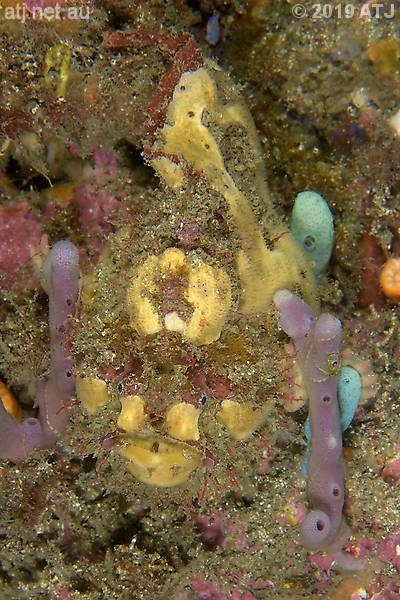
Red-fingered Anglerfish, Porophryne erythrodactylus. 11.5m.
I continued on to Little Big Rock. I swam up to the rock where "David", the Pot-bellied Seahorse, has been but initially swam past to look for the large yellow Red-fingered Anglerfish on the rock with the large green. She was where I had seen her last Sunday. I then went back to look for "David" and found him on the side of the larger rock.

Red-fingered Anglerfish, Porophryne erythrodactylus. 11.5m.
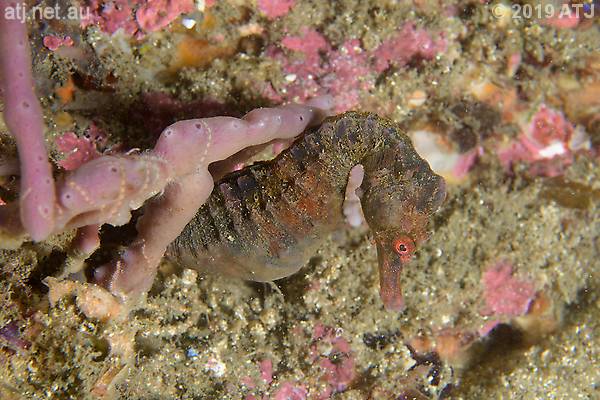
Male Pot-bellied Seahorse, Hippocampus abdominalis, ("David"). 12.1m.
I swam along the top of the reef to Di's Rock. I looked for anglerfish along the way. I looked under the end of the Di's Rock and spotted the large orange Red-fingered Anglerfish.

Red-fingered Anglerfish, Porophryne erythrodactylus. 11m.
I headed down to the rock above Pipefishes Hole. I looked on the adjacent rock and found the small orange Red-fingered Anglerfish. It was out from the sponge it had been hiding in last Sunday.
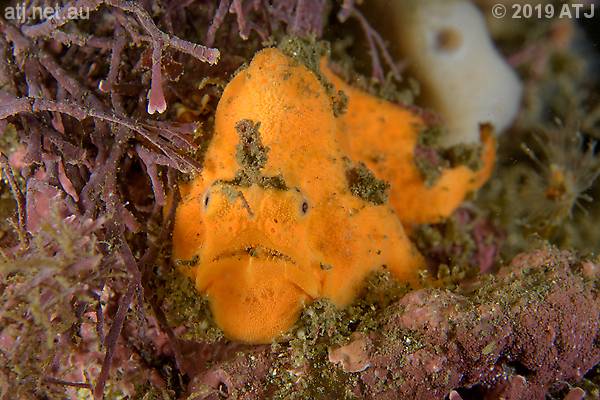
Red-fingered Anglerfish, Porophryne erythrodactylus. 11.5m.
I looked in Pipefishes Hole but could not see any pipefish. I looked in the kelp on the sand and spotted the juvenile Weedy Seadragon.

Juvenile Weedy Seadragon, Phyllopteryx taeniolatus. 12.7 m.
I headed towards the rocks where the other seahorses had been. I spotted a brightly patterned organism out in the open on one of the rocks. It was around the size of a tennis ball and I'd never seen anything like it. I took some photographs and carefully picked it up and turned it over. It had a foot and so was a gastropod. I later found out it is called Lamellaria australis and it is a type of snail with a small shell called a hypsegastropod.

Velutinid, Lamellaria australis. 11.9m.
I swam up to where I last saw the "map of Australia" orange Red-fingered Anglerfish and then down to the rocks in front of the exit. I looked around for anglerfish but found none. I headed for the boulders and ascended to Split Rock and did my safety stop. I swam underwater to the exit and got out.
Camera gear
Camera
Nikon D500
Lens
Nikon AF-S Micro Nikkor 60mm f/2.8G ED
Housing
Ikelite 6812.5
Lens port
Ikelite Flat Port 5502.41
Strobe
2 x Ikelite SubStrobe DS161